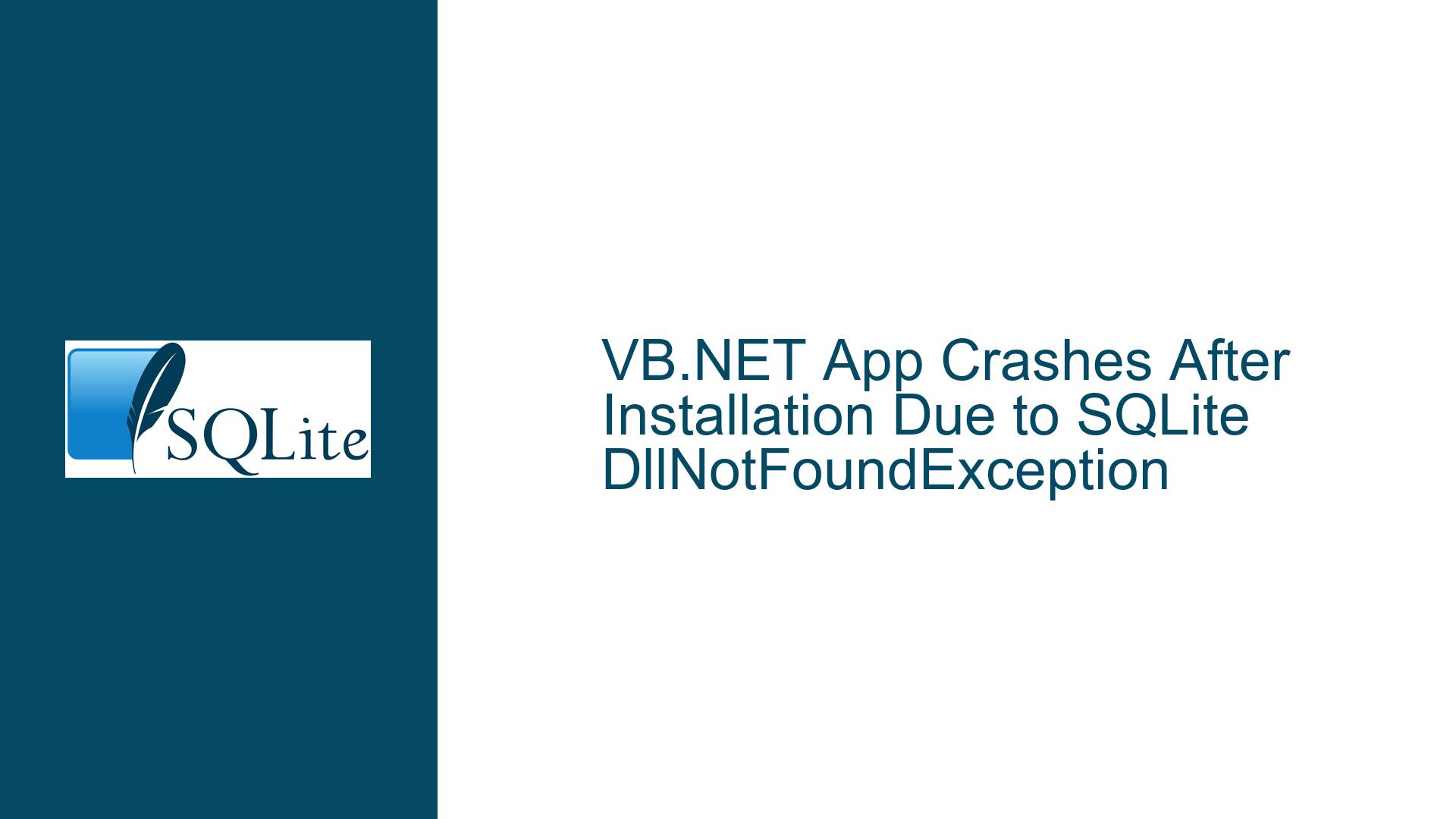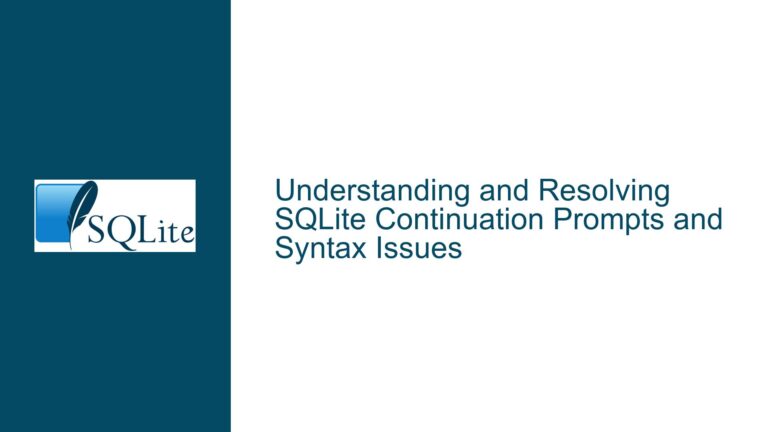VB.NET App Crashes After Installation Due to SQLite DllNotFoundException
Application Startup Failure with SQLite DllNotFoundException and Kernelbase.dll Exception
Issue Overview: SQLite Dependency Resolution in Deployed VB.NET Applications
The problem involves a VB.NET WinForms application developed in Visual Studio 2023 that functions correctly in debug and release modes but crashes immediately after installation. The crash manifests as a brief spinner animation followed by termination, with no user-facing error messages. Event logs reveal two critical errors:
System.DllNotFoundExceptionforsqlite3_config_noneinKERNELBASE.dll.- An unhandled exception chain starting at
SQLiteConnectioninstantiation, propagating toInvalidOperationExceptionduring form initialization.
The application relies on SQLite for data storage, with the database located at C:\{custom_directory}\database.sqlite. The installer deploys the app to C:\Program Files\WindowsApps\{package_id}, a restricted Windows AppX package directory. The crash occurs due to a failure to load SQLite’s native interop library (SQLite.Interop.dll), which is not correctly deployed or resolved at runtime. This issue is exacerbated by Windows AppX sandboxing, which restricts file system access and dependency resolution.
Key technical details:
- Exception Code
0xe0434352: Indicates a .NET runtime exception. - Faulting Module
KERNELBASE.dll: A Windows system DLL responsible for low-level operations, often involved in exception handling. - Missing Dependency Chain: The
System.Data.SQLite.dllwrapper attempts to callsqlite3_config_none(a SQLite configuration function) but cannot locate the nativeSQLite.Interop.dll. - Deployment Context: The application is packaged as a Windows Store-compatible AppX, subject to strict file system permissions and dependency isolation rules.
Root Causes: SQLite Deployment Misconfiguration and Runtime Environment Constraints
The crash stems from a combination of SQLite deployment oversights and Windows AppX sandboxing limitations. Below are the primary causes:
Incorrect SQLite Binary Deployment
TheSystem.Data.SQLiteNuGet package or manually referenced assemblies may not include platform-specificSQLite.Interop.dllfiles in the required directory structure. For SQLite to function:System.Data.SQLite.dllmust reside in the application’s root directory.SQLite.Interop.dllmust be placed inx86(32-bit) orx64(64-bit) subdirectories relative to the executable.
If these files are missing or placed incorrectly, the .NET runtime cannot load the native SQLite library, triggering theDllNotFoundException.
Architecture Mismatch Between Application and SQLite Binaries
The application is compiled for "Any CPU" but deployed with SQLite binaries for only one architecture (e.g., 32-bit). When running on a 64-bit OS, the .NET runtime may default to 64-bit mode, causing a mismatch with 32-bitSQLite.Interop.dll. Conversely, AppX packages enforce strict architecture alignment, and mixed deployments are unsupported.Windows AppX Sandboxing and File System Restrictions
Applications installed via the Microsoft Store or AppX packages run in a sandboxed environment with limited access to the file system. Key issues:- The database path
C:\{custom_directory}is inaccessible due to AppX write restrictions. - The
WindowsAppsdirectory prohibits modifications, preventing self-repair (e.g., extracting missing DLLs). - Dependency probing for
SQLite.Interop.dllfails because the runtime cannot traverse directories outside the package’s virtualized file system.
- The database path
Missing Microsoft Visual C++ Redistributable
SQLite’s native components depend on the Visual C++ runtime (e.g.,vcruntime140.dll). If omitted during deployment, the OS cannot resolve secondary dependencies, leading to silent failures.
Resolution: Fixing SQLite Deployment and Bypassing AppX Limitations
Step 1: Validate and Correct SQLite Binary Placement
Retrieve Correct Binaries
Download the officialSystem.Data.SQLitebinaries from sqlite.org. Use the Precompiled Binaries for .NET 4.6 (e.g.,sqlite-netFx46-binary-x64-2015-1.0.118.0.zip).- Avoid NuGet for deployment-critical scenarios; manually reference binaries to ensure control over file placement.
Reorganize Project Directories
Add the following structure to your VB.NET project:Project/ ├─ bin/ │ ├─ Release/ │ │ ├─ x86/ │ │ │ └─ SQLite.Interop.dll │ │ ├─ x64/ │ │ │ └─ SQLite.Interop.dll │ │ └─ System.Data.SQLite.dllEnsure the build action for
SQLite.Interop.dllis set to Content with Copy to Output Directory = Always.Update Project References
Remove NuGet-based SQLite references. Manually add a reference toSystem.Data.SQLite.dllvia Add Reference > Browse.
Step 2: Enforce Architecture Consistency
Set Explicit Build Targets
In Project Properties > Compile > Advanced Compile Options, set Target CPU tox86orx64(not "Any CPU"). This ensures the application matches the architecture of deployed SQLite binaries.Modify Installer Settings
In the Visual Studio Installer project, specify the same architecture (x86/x64) as the SQLite binaries. Mixed architectures in AppX packages are invalid.
Step 3: Adapt Database Path for AppX Sandboxing
Relocate the Database
Avoid hardcoding paths likeC:\. UseEnvironment.GetFolderPath(Environment.SpecialFolder.CommonApplicationData)to resolve toC:\ProgramData\{AppName}\database.sqlite, which is writable in most contexts.Handle First-Run Initialization
Add startup code to copy the database from the installation directory toProgramDataif it doesn’t exist:Dim appDataPath As String = Path.Combine( Environment.GetFolderPath(Environment.SpecialFolder.CommonApplicationData), "MailLabels" ) If Not Directory.Exists(appDataPath) Then Directory.CreateDirectory(appDataPath) End If Dim dbDest As String = Path.Combine(appDataPath, "database.sqlite") If Not File.Exists(dbDest) Then File.Copy("C:\SqliteDb\database.sqlite", dbDest) End If
Step 4: Diagnose Dependency Loading with Process Monitor
Capture File System Activity
Use Process Monitor to trace file access attempts during startup:- Launch ProcMon.
- Add filters:
Process Name = MailLabels.exe,Result = NAME NOT FOUND. - Identify missing files (e.g.,
SQLite.Interop.dll,vcruntime140.dll).
Resolve Missing Dependencies
- If
vcruntime140.dllis missing, bundle the Visual C++ Redistributable with your installer. - Ensure
SQLite.Interop.dllis inx86orx64subdirectories relative to the executable.
- If
Step 5: Simplify Deployment with Traditional Installers
Avoid AppX for Non-Store Deployments
Use InnoSetup or Advanced Installer to create a standard MSI/EXE installer. These tools:- Correctly bundle dependencies.
- Install to
Program Fileswithout sandboxing. - Allow desktop shortcuts and registry entries.
Test Deployment Locally
Copy thebin\Releasedirectory to a test machine (without Visual Studio). Verify:- The application launches.
- The database is accessible at
ProgramData\{AppName}.
Step 6: Prepare for Microsoft Store Submission
Convert to MSIX Packaging
Use the MSIX Packaging Tool to repackage your application. MSIX:- Supports dependency declaration (include
SQLite.Interop.dllas content). - Allows file system access via declared capabilities in
Package.appxmanifest:<Capabilities> <rescap:Capability Name="broadFileSystemAccess" /> </Capabilities>
- Supports dependency declaration (include
Test in Windows Sandbox
Validate the MSIX package in an isolated environment to detect permission issues early.
By addressing SQLite’s deployment mechanics, aligning architectures, and adapting to Windows AppX constraints, the application will reliably start post-installation. For further refinement, integrate logging to capture runtime errors and validate database connectivity before initializing forms.






